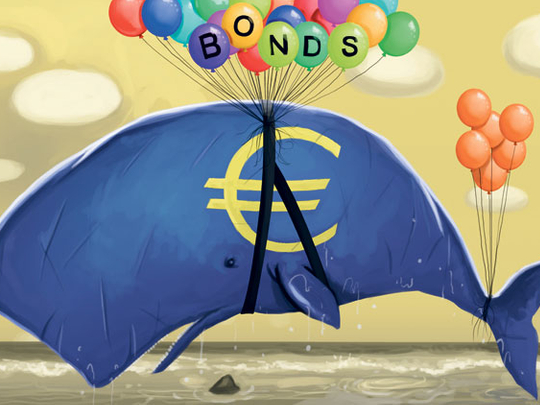
The phrase "overnight sensation" isn't usually applicable to the bond market. But if financiers had charts the way the music industry does, the debut bonds issued by the European Financial Stability Facility (EFSF) last week would be in the top slot.
Designed to rescue the euro, by helping to pay for the bailouts of the single currency's peripheral members, the issue was hugely popular with investors.
So that's the problem solved, then. All the euro-area governments have to do is issue debt jointly, and the bond markets won't be able to get enough of it.
Think again. Just because investors are piling into something doesn't mean it is a solid investment. They jumped into dot-com shares as well — before the bust of 2000.
In reality, the euro rescue bonds are just as risky. And investors may well end up getting burned.
There is no disputing that the first issue was a roaring success. The 5 billion euros ($6.9 billion) of five-year debt was massively oversubscribed. Five hundred bidders offered to buy 44.5 billion euros of the bonds, almost 10 times what was available. At this rate, not only will the fund be able to bail out Ireland. It can rescue Portugal and probably Spain as well.
The demand is by no means satiated. Asian investors bought about 38 per cent of the issue, and there are huge pools of capital in that continent to be tapped. Goldman Sachs Group Inc. says the stability facility should buy the bonds of highly indebted euro-area nations because it can raise capital so much more cheaply than governments can.
Out of money
Of course, on the surface, the bonds look like a good deal. They are AAA rated, and backed by most euro-area countries. Greece and Ireland are excluded on the rather obvious grounds that they have already run out of money. The fund should also be making some pretty easy profits.
The 5 billion euros it raised last week cost 2.89 per cent, but will be lent on to Ireland at almost 6 per cent. Even the most ruthless credit-card company would think that was a generous margin.
But look a bit closer, and the picture isn't so pretty.
In finance, as in so much else in life, it's a good idea to go back to first principles. This is, in effect, a sovereign bond — the only difference is that it is backed by a group of nations, rather than just one.
Investors in any sovereign bond rely on two things. The first is the long-term sustainability of the finances of the government issuing it. The second is their willingness to repay their debts, rather than face the humiliation of a default. There is nothing else. Sovereign-bond owners have no realistic claim on the assets of a nation. If the UK government decides not to pay back its debts, for example, investors can't come and dismantle the Tower of London. If the US government reneges on its debt, the holders of Treasury bills can't take Hawaii in compensation. They have no real recourse.
So how secure does the EFSF bond look? Not very.
The fund is all about shifting debt from one place to another. After the credit crunch, it was moved from banks to governments. Now it is being shuffled between governments. But the one important lesson of the last few years, surely, is that shuffling debt around doesn't make it more affordable.
Of the countries backing it, only six are AAA rated: Germany, France, the Netherlands, Austria, Finland and Luxembourg. None of the others has the top rating. Some, like Spain and Italy, have serious questions over their credit worthiness. Surely we learned during the subprime debacle that mixing up good debts with dodgy ones doesn't make the system safer. It makes it a whole lot more dangerous.
German opinion
If it comes to a crunch, who is actually standing behind this paper? Finland and Luxembourg are too small to count for anything. Austria and the Netherlands can't sustain the euro by themselves: They have a combined population of 25 million, about half that of Spain. The long-term sustainability of French public finances is in question. The only really rock-steady country on that list is Germany. So what stands behind these bonds is German public opinion.
But one poll shows that 49 per cent of Germans are now in favour of ditching the euro and going back to the deutsche mark. And 77 per cent, quite rightly as it happens, believe they haven't benefited from the single currency. The Germans are only a whisker away from concluding that the whole experiment is a failure and giving up on it.
The bonds are guaranteed only by the willingness of the Germans to carry on funding the single currency. They might just do so for now. But if the Greeks and the Irish, and then the Portuguese and the Spanish, keep coming back for more money, that remaining support will evaporate very quickly.
And then what are bondholders left with? Some brightly coloured pieces of paper that might be put up on a wall somewhere along with 19th century railway bonds, and 1990s dot-com shares.
— Matthew Lynn is author of "Bust," a book on the Greek debt crisis. The opinions expressed are his own.












